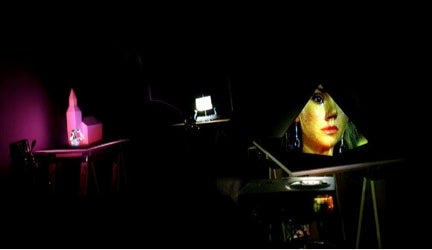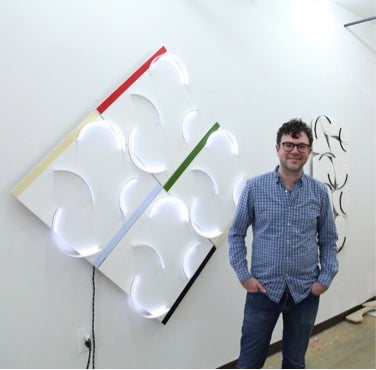
JD Walsh is a multimedia artist living in Brooklyn. Walsh lived in Atlanta for several years, and I was interested in hearing what he thought the main differences were between the two cities’ art scenes. Walsh also works as a video editor and has shown at such spaces as Sardine in Bushwick. He’s also a musician and has played in various indie rock bands over the years. His artwork always leaves you guessing, because it can range from a computer program to a high-tech video installation to inventive sculptures—some that even light up! He is happily married and has a son. It was great catching up with my old friend, hearing what he’s been up to and inspired by lately, and revisiting the New York art scene through the eyes of one of my favorite artists.
Sherri Caudell: For your 2013 solo exhibition “Room Tone” at Sardine Gallery in Brooklyn, how did you decide which pieces to include? What were you thinking about at the time, and what materials were you primarily working with?
JD Walsh: By the time “Room Tone” happened, my work had shifted a bit more into abstraction, which was kind of a new thing for me. My older work often used video, but for “Room Tone” any electronic images had been reduced to only light—and were also more minimal than things I’d been doing previously. I showed four or five pieces where I stretched hand-painted fabric over these geometric assemblages, so that the viewer had only hints or suggestions of the obscured shapes underneath. The centerpiece of the show was a large wall sculpture called Phased Arcs, where groups of LED lights fade in and out at different intervals, creating a kind of shifting, musical effect based on chance combinations.
SC: What do the shapes and forms in the “Room Tone” works signify for you? What are you trying to communicate to the viewer?
JDW: I wouldn’t say they signify anything in particular. I do feel they need to be basic, primary shapes, because it’s not the shapes that are important but the system of obscuring the forms that is more interesting to me. There is an air of mystery when you can’t see the underlying structure completely.
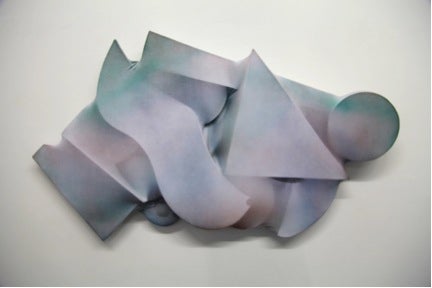
SC: Your work has become more sculptural. Have you moved away from video entirely?
JDW: I can’t say I’ve moved away from video entirely, but I have changed the way I approach it. Keep in mind, I make my living as a video editor, so when I’m in my studio, it’s not always the first thing I want to do. For my artwork, I’ve adopted a more minimal approach across the board. So, for example, lately I’ve been very interested in simply using LED lights as a moving image rather than video. It has all the necessary elements of an electronic, time-based image. It also helps to have this kind of simple approach so as not to distract from the sculptural elements of the works. But I do still work in video. In 2012, I did a large-scale multichannel video installation as part of a public commission in Toronto, called Ensemble for Mixed Use. So it’s still very much a part of my vocabulary. But right now I’m focusing on a more austere application of it.
Ensemble for Mixed Use, 2012 from JD Walsh on Vimeo.
SC: Are you inspired by graphic design?
JDW: Not specifically, but I do feel like a lot of my work has some element of geometry to it, or elements that could be considered “graphic.” So I can see how one would think that. But I can’t say that I consciously seek it out.
SC: Do you have a fascination with facial features? I’ve noticed eyes, lips, and broken up faces recurring in your work.
JDW: I definitely have made a few pieces where facial features recombine based on chance operations. [A video and a series of prints.] It’s not so much a fascination with them as that they were appropriate for the system I created.
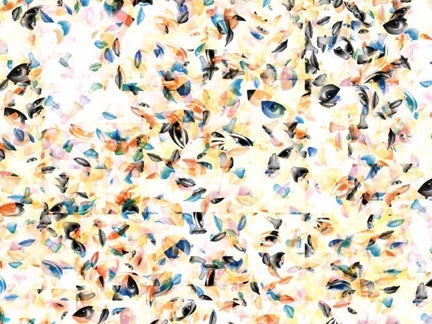
SC: How do you feel your work relates to Pop art, if at all? Your use of some name brand products brings this to mind. I’m thinking a lot about your “Slow Fade.”
JDW: I think Pop art probably has been an influence on my work, maybe more so with my earlier pieces, like the “Slow Fade” series. I’ve often felt that certain artists working in that vein deal with efficiency very well. They can be very poetic with simple means—I admire this. I’m thinking of a Lichtenstein retrospective I saw at the Hirshhorn a couple of years ago, which I thought was great.
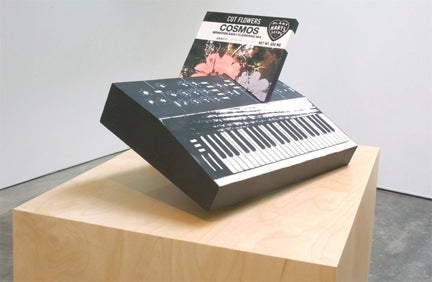
SC: Who are some current video artists that you like or past artists that you always come back to?
JDW: Kenneth Anger, Cory Arcangel, Shana Moulton, Hollis Frampton, Christian Marclay, Steina Vasulka, Michael Snow, just to name a few.
SC: One of my favorite pieces by you is Dramatization Disc, the video installation you did at Galerie Steinek in Vienna, Austria. Since you’re a musician, do you make your own music for your videos?
JDW: Anytime there is sound or music in my work, I made it. It’s one of my favorite things to do. I’m not sure how it informs my visual work; I often think of them as one and the same.
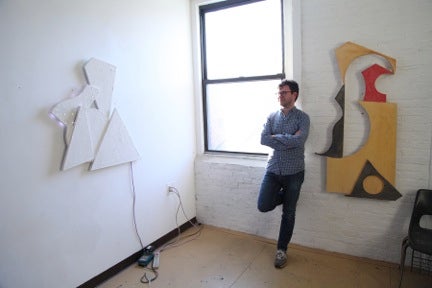
SC: What music have you been listening to lately?
JDW: In no particular order: Television, Future Islands, the Police, Cheap Time, William Onyeabor, Grateful Dead, and Francis and the Lights.
SC: You’ve been successful as an artist, in Atlanta and in New York. What are the main differences you see between the two art scenes?
JDW: In Atlanta, it seemed relatively easy to get to know people who were active in the art scene. Obviously, it’s a smaller scene, so that makes sense. The New York art world is so surreally huge; it sometimes feels like art worlds. Granted, it’s been quite a while since I lived in Atlanta, so I don’t know what it’s like these days. One great thing was the prospect of having inexpensive space. I lived in Castleberry Hill in 1999. By the time I came back to visit, just a few years later, I was shocked at how the neighborhood had changed—galleries, bars, coffee shops … the typical story. I wish they’d been around when I lived there. But to have so much space was fantastic. I was still really young. I don’t know how I would have processed New York at that age. After a while, I was just ready to move on and see what all the fuss was about in New York.
SC: Can you talk a little bit about the art you made while in Atlanta? You have work in the High Museum of Art’s collection. You also taught at the Atlanta College of Art and exhibited with Solomon Projects. Can you tell us about those experiences?
JDW: I had moved there to teach at the Atlanta College of Art. I was pretty young, maybe 22. That school by itself was a great hub for people active in the scene. I’m thinking specifically of Sara Hornbacher, head of the video department (she was my boss and is now my dear friend). She was a New York expat herself, and I had never really met anyone like her. She was 100 percent invested in fostering an artistic community through teaching, art-making, and just socializing. So she was a big force. There was also a guy named Jason Forrest who was an art critic at the AJC, and an artist. He was such a gadfly, and he wasn’t afraid to voice his opinions (in the paper!) on art he deemed substandard—people must have hated that! At the same time, he could be extremely supportive of stuff he liked. He was also a real catalyst, making connections between people. This is how I was introduced to Nancy Solomon [of Solomon Projects]. A video sculpture that I showed there, called Weekend, was acquired by the High.
SC: I know you worked for artist Tony Oursler for a number of years. Did his work have any impact on your own?
JDW: Maybe subconsciously. It definitely taught me the value of hard work. That guy is an extremely hard worker.
SC: You’ve collaborated in the past with painter and video artist Patrick Brennan, for the video piece The Stranger. How do you feel about collaborating with other artists? Is it something you would be open to doing again?
JDW: I’ve done a number of collaborations with artists over the years, and I certainly hope to do it again. I’ve never understood why it’s so common in music but not in visual art. I really enjoy it, but it does have to be the right kind of project.
SC: In the past, you’ve created your own computer programs to use in your work. Do you see yourself ever returning to this?
JDW: Making computer programs, pouring plaster, scoring a film, composing a performance—these are all equally useful activities as long as the idea calls for it. Programming is good for certain things, like generating randomness, or outsourcing decisions so that you don’t have to make them. I tend to opt for the simplest uses of it.
SC: How has becoming a father affected your artwork and art-making process?
JDW: Well, it’s mostly about how I spend my free time, because I don’t have much of it. On the positive side, it can teach you to be more focused about what you do, and waste less time. I also have less tolerance for bullshit, but that’s probably because I’m tired.
Sherri Caudell, a poet and writer from Atlanta, is the new poetry editor of Loose Change magazine, published by WonderRoot.
